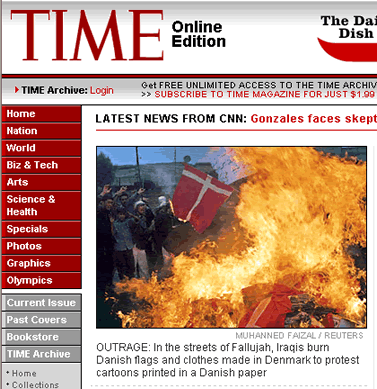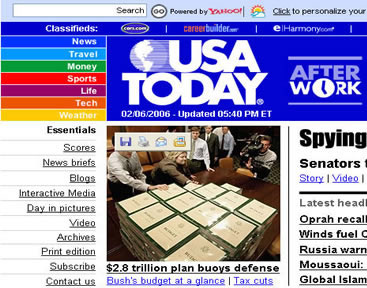GENRE ANALYSIS: NEWS SITES
NAVIGATION MENU
*OVERVIEW
*WRITERS/DEVELOPERS
*AUDIENCE/USERS
*FORMAT/ORGINIZATION
*FORMALITY
*VISUALS
*VARIATIONS
VISUALS
Here is where a truly great deal of variation can be seen amongst news web pages. It is possible to have a web page which effectively delivers the news to people without color photos or flashy images or any pictures at all. However, most news sources know that visuals can come across as both organizational aids and as added flair and appeal. The major commercial news sites examined above (such as CNN, USAToday and FOXNews) all use many color photos with almost each story, as well as graphics for links, logos, sections, navigation bars and so on. But they are careful never to overwhelm those visiting their page.
Taken as a single page, USAToday offers at least one color photo with most of its stories, easy to use navigation buttons and graphics, as well as a limited asortment of logos and varous methods of branding.
On the other hand, there are sites (usually armature or independent) which can effectively transmit news without much visual aid. These sites are more commonly Blogs, personal sites and independent sites. Also, their are news wire services, many of which have no pictures with any of their stories but are regarded as some of the most objective and accurate reporting available--the site newswire being one example.
FORMAT AND ORGINIZATION
When studying the news sites of the internet, one notices many similar features and themes. But what they all really have in common is that they are all easy to use, simple to navigate, and they present all the material clearly. All news sites share a few important but simple elements. The major news headlines are on the center of the homepage. The sections of news (such as sports, finance or travel) are presented as a framed menu to the side. A navigation menu usually runs along the top of the page. Also, as one scrolls down the page of any given section, the importance of the articles becomes less.
As can be seen from the pictures above, USAToday uses color coded sections to orgonize thier content (just as they do with their news paper). The sections are accesable via a menu running down the left side of the page. The USA Today logo and title bar run across the top of the page. These features remain static throughout all navigation for simplicity and clarity.
In this manner, news sites have constructed their pages much like an interactive news paper. Just like a news paper their are headlines, secions, pictures, bylines for articles and so on. The pictures below are from three major news web sties. Notice the similarities. The only real differences come from branding and marketing.
WRITERS AND DEVELOPERS
When dealing with news sites, just like any other professional news source, the writers should always be professional news journalists. Some pages infact, may simply use articles from their newspaper or TV show. For example, on the New York Times' home page, their credited writiers are journalists, many of whom write for the paper itself. On the other side, news sites that are extensions of TV networks or shows, such as FOXNews, feature the stories discussed on TV. Even anchors and personalities of the various shows on TV news networks contribute as writers to that stations web site. And as far as web-specific news sites, a wide variety of writers, journalists, bloggers and even celebrities and famous columnists makeup the team of contributors.
USAToday uses a large amount of writing from their news print edition. In addition, the site offers some content from news wire bullitens as well as OP/ED contributions.
If one were to look to a TV news site like CNN there are writers who are professional journalists, writers who are anchors on the network--such as Anderson Cooper--as well as correspondents and openly submitted opinion articles. But if one were to look to a Radio news sites (NPR) or news magazine sites (TIME) its pretty much the same. Those who contribute to the radio station or magazine or whatever the format, are at the same time contributing to their mirror site on the web.
VARIATIONS
In an attempt to be as formal and as easily usable as possible, news pages such as USAToday attempt to give as little variation in their design. Any variations come only as aids in navigation. For example, each section of the page has a different color scheme so that it is easily identifiable. But even within these different sections and pages, the overall layout is the same as the homepage.
Aside from branding and marketing variations--which usually only yield differing color schemes, logos and such--the world of news web sites is without much variation. We have mentioned the different kinds of sites--those based off TV, Radio or news papers, those based off of personal web logs, and those of news wire associations. The variation in use of visual aids was also commented upon. However, despite these varrying sources and formats, all proper news pages have one aim in mind, and that is to deliver the news to the widest audience possible and in the most clear and effective manner. With this shared goal, one sees a sriking similarity in every news web page. Navigation bars, headlines, news archives and search bars, compartamenalization based on sections of interest and much more. The real variation comes into play when one considers who authored the web page.
Television news sites offer more links to the various shows on their channel. Radio news sites offer pod casts and transcripts of shows. Strictly web based news sites put more emphasis on the page itself, with forums, archives, search tools and the like. And again, the amature sites such as news blogs offer the widest range of variation, as would be expected.
AUDIENCE AND USERS
Who is the intended audience for USAToday as well as any news site? Obviously, creators of news sites are aiming to address users of the internet who whish to stay current on events of the world. Furthermore, many news sites draw users from their other address formats--readers of USA Today the news paper might be inclined to visit the web site, for example. In the end, these qualifications equate to a range of people, probably between 20 years old to 50 years old, both male and female. It is this age range which sees the most people who both want to access news information and are physically able and knowledgeable enough to do so.
This audience is obviously a wide range of peoples, both young and old, male and female. Thus when designing the site, the creators must keep this in mind so that their web page is easily accessable, clearly orgonized and does not descriminate anyone that might want to use the sight. A tech savy twenty-something must not be the only one able to appreceate all the features of the web page. A wide audience thus requires that the page be simple, easy to use and never complex in any way.


FORMALITY
The format of all news sites is formal and professional. Like any other form of news and journalism, integrity and credibility must be ensured and the audience must feel as though they are receiving news from a reputable and credible source. Having a news site that looks sloppy, unprofessional or amateurish would undermine any journalistic integrity the site was hoping to convey. Again, the formality of each of our example pages can be seen in the pictures above or by visiting the links.
Formality must also been seen as an extension of format and orginization. To create a web page which emits a great deal of formality, one must ensure the page is well formatted and orgonized in an extreemly clear and easy to follow manner. A web page that is difficult to navigate and not easy to look at will result in a very low level of formality.
OVERVIEW
News sites, or "news portals", are very popular and very useful web pages. News sites typically display all the major news stories from a specific country or the entire globe. News sites can be web-based versions of TV news channels, news papers, magazines and even radio news programs. There are also news sites and portals which are web-specific sites that were originally intended for the internet. But all news sites are the same in their purpose: to deliver the news.
News pages, such as USAToday, CNN and FOXNews (to name just a few) all aim to disseminate news and information easily to a wide audience. Therefore, in the following sections it will be shown how most major news pages share this common goal and use nearly identical methods to achieve their aim. In addition, any varyation or differences between major news sites will be addressed and examined.
For the sake of brevity, we will be focusing on USAToday as the template page for our analysis. We will also be incorporating examples from similar sites for other major news orginizations.